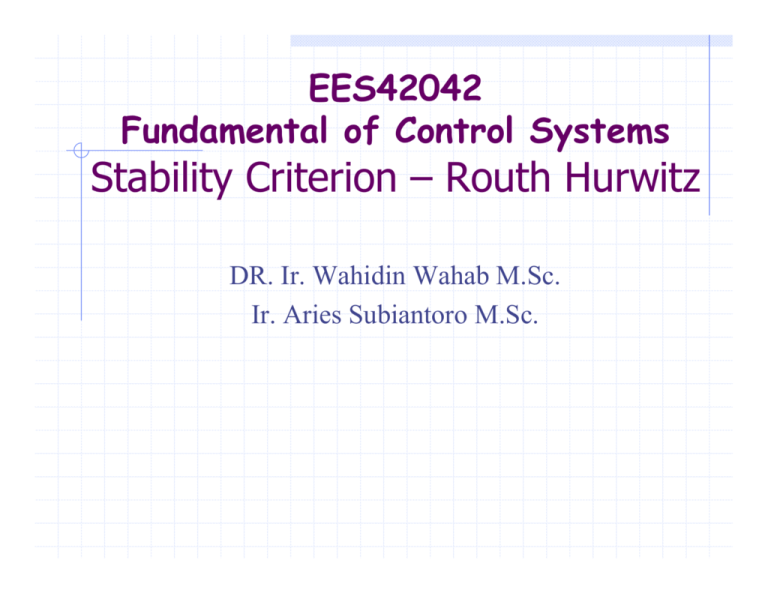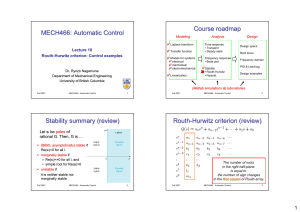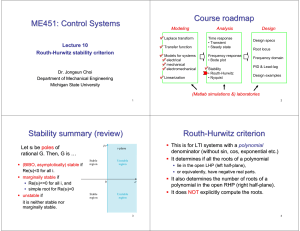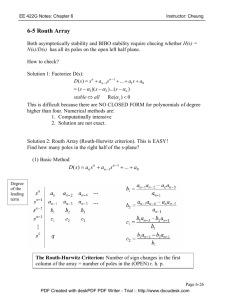
EES42042
Fundamental of Control Systems
Stability Criterion – Routh Hurwitz
DR. Ir. Wahidin Wahab M.Sc.
Ir. Aries Subiantoro M.Sc.
2
Stability
A
system is stable if for a finite input the
output is similarly finite
A system which is stable must have ALL its
poles in the left half of the s-plane
Figure 6.1
Closed-loop poles
and response:
a. stable system;
b. unstable system
Control Systems Engineering, Fourth Edition by Norman S. Nise
Copyright © 2004 by John Wiley & Sons. All rights reserved.
Figure 6.2
Common cause
of problems in
finding closed-loop
poles:
a. original system;
b. equivalent
system
Control Systems Engineering, Fourth Edition by Norman S. Nise
Copyright © 2004 by John Wiley & Sons. All rights reserved.
Figure 6.3
Equivalent closedloop
transfer function
Control Systems Engineering, Fourth Edition by Norman S. Nise
Copyright © 2004 by John Wiley & Sons. All rights reserved.
Routh-Hurwitz Stability
Criterion
This
is a means of detecting unstable poles
from the denominator polynomial of a t.f.
without actually calculating the roots.
Write the denominator polynomial in the following
form and equate to zero This is the characteristic equation.
a 0 s n + a1s n − 1 + a 2 s n − 2 +.....+ a n − 1s + a n = 0
Note that a n ≠ 0
i.e. remove any zero root
6
Routh-Hurwitz Stability
Criterion
If any of the coefficients is zero or negative in the
presence of at least one positive coefficient there
are imaginary roots or roots in the right half plane
i.e. unstable roots
7
Routh-Hurwitz Stability
Criterion
if all coefficients are + ve form the Routh Array
sn
a0
a2
a4
sn − 1
a1
a3
a5 a 7 .....
sn − 1
b1
b2
b3 b4 .....
sn − 2
.
c1
c2
c3 c4 .....
.
s2
e1 e2
s1
f1
s0
g1
a 6 .....
8
Routh-Hurwitz Stability
Criterion
a1a 2 − a 0 a 3
b1 =
a1
a1a 4 − a 0 a5
b2 =
a1
a1a 6 − a 0 a 7
b3 =
a1
9
Routh-Hurwitz Stability
Criterion
b1a 3 − a1b2
c1 =
b1
b1a5 − a1b3
c2 =
b1
b1a 7 − a1b4
c3 =
b1
10
Routh-Hurwitz Stability
Criterion
11
This process is continued until the nth row is completed
The number of roots of the characteristic lying in the
right half of the s - plane (unstable roots) is equal to the
numbe rof sign changes in the first column of the Routh
array.
Table 6.1
Initial layout for Routh table
Control Systems Engineering, Fourth Edition by Norman S. Nise
Copyright © 2004 by John Wiley & Sons. All rights reserved.
Table 6.2
Completed Routh table
Control Systems Engineering, Fourth Edition by Norman S. Nise
Copyright © 2004 by John Wiley & Sons. All rights reserved.
Figure 6.4
a. Feedback
system for
Example 6.1;
b. equivalent
closed-loop
system
Control Systems Engineering, Fourth Edition by Norman S. Nise
Copyright © 2004 by John Wiley & Sons. All rights reserved.
Table 6.3
Completed Routh table for Example 6.1
Control Systems Engineering, Fourth Edition by Norman S. Nise
Copyright © 2004 by John Wiley & Sons. All rights reserved.
16
Example 2
Determine if the following polynomial has roots in the
right half of the s - plane
s 4 + 2s 3 + 3s 2 + 4s + 5 = 0
First two rows of Routh array formed from coefficients
s4 1
3
s3 2
4
5
17
Example 2
Form next row
s4 1
s
3
3
2
4
s2 1
5
5
2 × 3− 1× 4
1=
2
2 × 5− 1× 0
5=
2
18
Example 2
Form next row
s4 1
3
s3 2
4
s2 1
5
s1 − 6
5
1× 4 − 2 × 5
−6=
1
19
Example 2
Form next row
s4 1
s
3
3
2
4
s2 1
5
5
− 6 × 5− 1× 0
5=
−6
s1 − 6
s0 5
Note two sign changes therefore two roots in RHP
20
Example 3
Apply Routh' s criterion to the following polynomial
to determine the condition for the existence of stable
roots
a 0 s 3 + a1s 2 + a 2 s + a 3 = 0
21
Example 3
a0 s 3 + a1s 2 + a2 s + a3 = 0
→ Routh Array
s 3 a0 a 2
2
s a1 a3
a1a2 − a0 a3
s
a1
1
0
s a3
22
Example 3
assuming all coefficients are positive the condition
for stable roots is that
a1a 2 > a 0 a 3
23
Routh Array - Special Cases
Case
of a zero in the 1st column
For example
s 3 + 2s 2 + s + 2 = 0
Routh Array
This presents a problem
s3 1 1
s2 2
s 0
2
when we come to obtain the
4th row - divide by zero
24
Routh Array - Special Cases
Case
of a zero in the 1st column
Define a small + ve number ε and evaluate whole array
Routh Array
s3 1 1
s2 2
s ε
1 2
2
Note no sign change indicating roots on imaginary axis
25
Routh Array - Special Cases
Case of a zero in the
Consider the polynomial
1st column
s 3 − 3s + 2
Routh array
−3
s31
s 0≈ε
2
s −3−
1
s0 2
2
2
ε
Two sign changes therefore two
RHP roots
Table 6.4
Completed Routh table for Example 6.2
Control Systems Engineering, Fourth Edition by Norman S. Nise
Copyright © 2004 by John Wiley & Sons. All rights reserved.
Table 6.5
Determining signs in first column of a Routh table with
zero as first element in a row
Control Systems Engineering, Fourth Edition by Norman S. Nise
Copyright © 2004 by John Wiley & Sons. All rights reserved.
Table 6.6
Routh table for Example 6.3
Control Systems Engineering, Fourth Edition by Norman S. Nise
Copyright © 2004 by John Wiley & Sons. All rights reserved.
29
Routh Array - Special Cases
Case
of a row of zeros
– roots of equal magnitude but opposite signs or
two conjugate imaginary roots
s5 + 2s 4 + 24s 3 + 48s 2 − 25s − 50 = 0
Auxiliary eqn.
5
s
1
24
− 25
s4
2
48
− 50
s3
0
0
2s 4 + 48s 2 − 50 = 0
30
Routh Array - Special Cases
Case
of a row of zeros
P( s) = 2s 4 + 48s 2 − 50 = 0
3
(
)
P ′ s = 8s + 96s
replace row with coeficients of P ′ ( s)
31
Routh Array - Special Cases
Case
of a row of zeros
s5 + 2s4 + 24s3 + 48s 2 − 25s − 50 = 0
s5
1
24
− 25
s4
2
48
− 50
s3
8
96
s2
24
− 50
s1
112.7
s0 − 50
0
One sign change one root with +ve
real part
Table 6.7
Routh table for Example 6.4
Control Systems Engineering, Fourth Edition by Norman S. Nise
Copyright © 2004 by John Wiley & Sons. All rights reserved.
Figure 6.5
Root positions
to generate even
polynomials:
A , B, C,
or any combination
Control Systems Engineering, Fourth Edition by Norman S. Nise
Copyright © 2004 by John Wiley & Sons. All rights reserved.
Table 6.8
Routh table for Example 6.5
Control Systems Engineering, Fourth Edition by Norman S. Nise
Copyright © 2004 by John Wiley & Sons. All rights reserved.
Table 6.9
Summary of pole locations for Example 6.5
Control Systems Engineering, Fourth Edition by Norman S. Nise
Copyright © 2004 by John Wiley & Sons. All rights reserved.
Figure 6.8
Feedback
control system
for Example 6.8
Control Systems Engineering, Fourth Edition by Norman S. Nise
Copyright © 2004 by John Wiley & Sons. All rights reserved.
Table 6.13
Routh table for Example 6.8
Control Systems Engineering, Fourth Edition by Norman S. Nise
Copyright © 2004 by John Wiley & Sons. All rights reserved.
Table 6.14
Summary of pole locations for Example 6.5
Control Systems Engineering, Fourth Edition by Norman S. Nise
Copyright © 2004 by John Wiley & Sons. All rights reserved.
39
Use of Routh Test
Routh
test only tells us whether or not a
system is stable
does not give the DEGREE of stability
need to have closed loop characteristic
equation
– would be more convenient to work from open
loop t.f.







